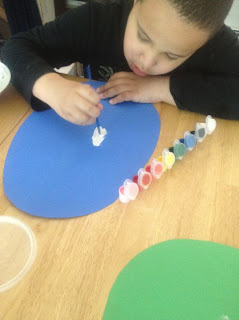The following is a guest post by Eileen Carter-Campos.
As a first grade and preschool teacher for many years, I always felt the need to incorporate a literature connection in all of my lessons. I found it to be beneficial to "all" of the learners. It engaged the visual learner who had to see what I was teaching them, the tactile learner who felt the need to manipulate objects, the auditory learner so that they could hear the selection and the model of fluency, and I would even try to incorporate a song or movement for that kinesthetic learner. It worked like a charm. The children were better able to comprehend the story, were actively engaged, and they walked away with a piece that they had created themselves and took pride in.
The finished product was a masterpiece and the children loved it. The children took pride in their work and they were eager to display and celebrate what they had created from a book.
The book, Chicka Chicka 123, is great for mathematics and enabled me to see if the children were able to identify the numbers in order, as well as identify a missing number. With the older grades I often had them create a number model, and then they had to find the total for that number model. This helped me to see which children were struggling with number sense.
Another great literature connection for this time of year is Rechenka’s Egg by Patricia Polacco. The children listen to a tale told of a grandmother in Moscow. The story unfolds when Babushka saves a goose that is hurt by hunters. Babushka takes the goose in, nourishing it while still preparing for the the Easter festival. One day, accidentally, the goose breaks all of the eggs that Babushka has created. But in return, it gives Babushka a beautifully painted egg each day for the next 12 days. I always love to focus on the lesson of generosity and helping others in need within the selection.
I also love for the children to move onto creating that very special egg for themselves.
So the children are given an oval-shaped piece of construction paper, or I give them the choice of creating their own shaped oval. The children then get to create designs on their egg. After they are finished outlining designs I have them decorate it. The children may follow the design with some pipe cleaners, feathers, glitter, or decals. The children may also be given the option of bringing out their creativity and painting their own egg. With the older grades I like to incorporate a writing piece. They are able to write about a time that they were generous to someone and how it made them feel to be this way. You also can do the reverse and have them discuss a time when they were not so nice, and what they can do to change that action.
There are many ways that we can incorporate literacy into our daily activities so that the children comprehend the story better and you are able to touch on all learning styles, while really allowing the children to socialize with their peers. I believe the children will have a better understanding of the text, and they will also continue to gain an enjoyment of literature.
This will increase that love for reading.





